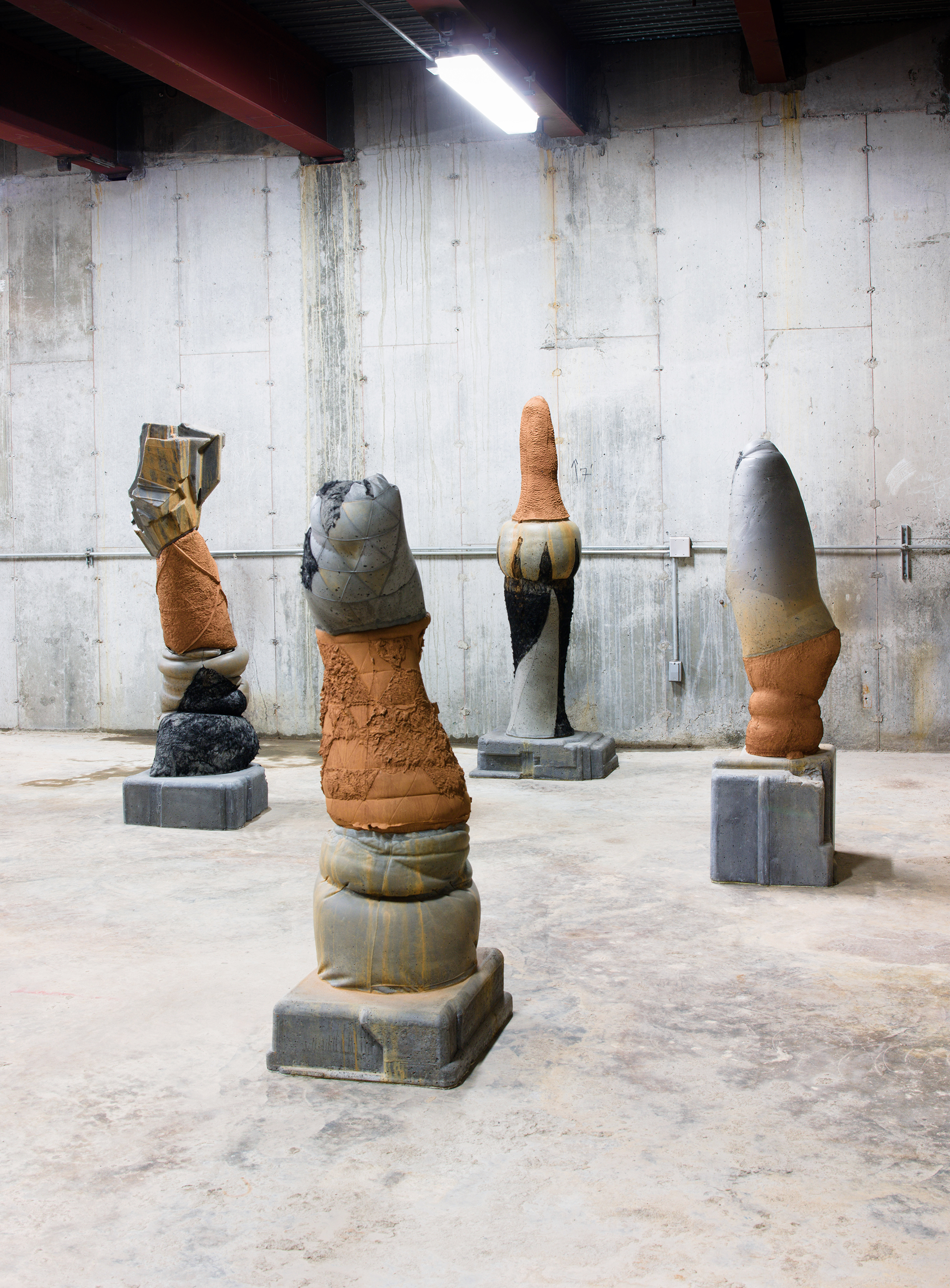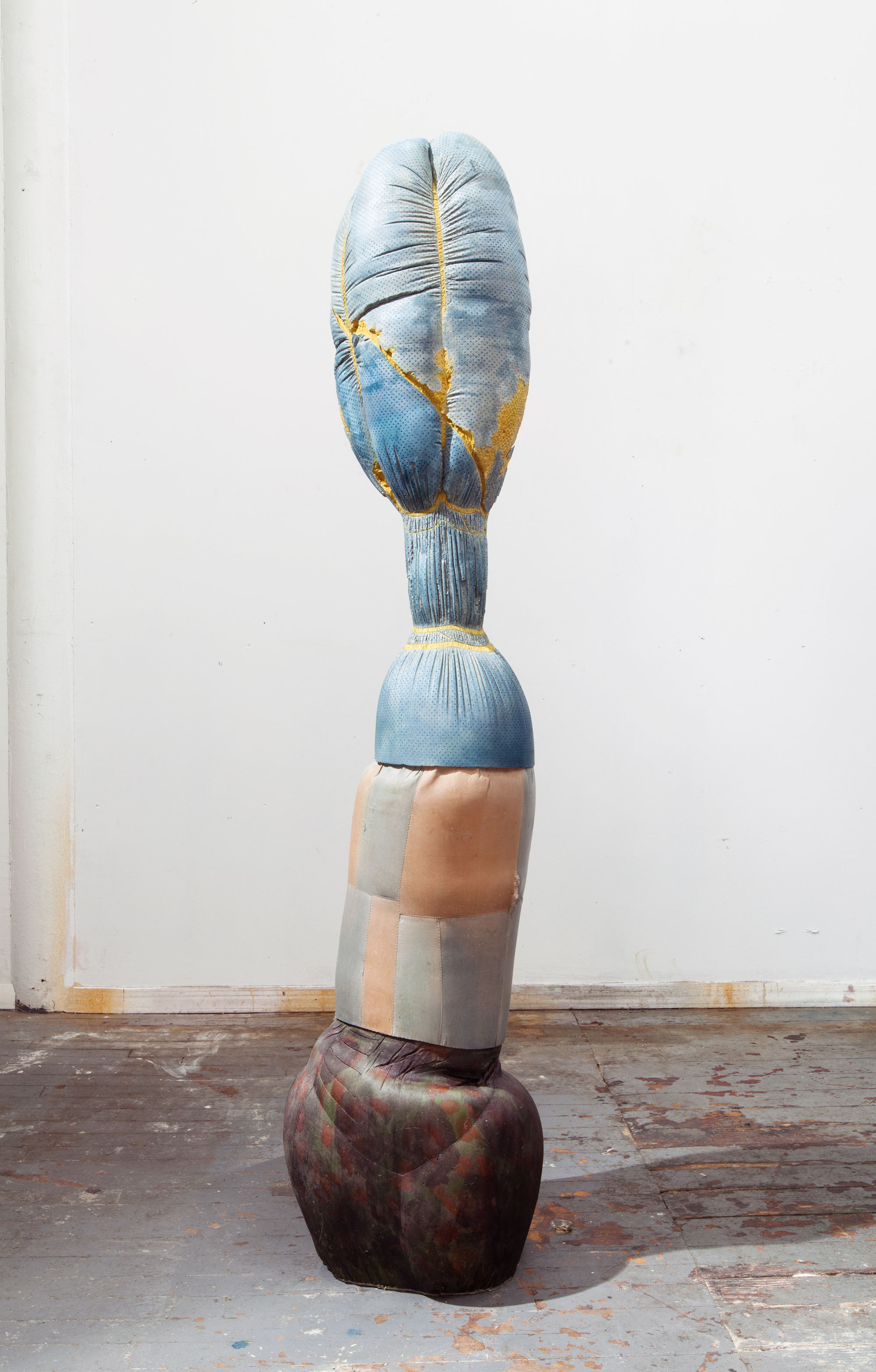Purple Magazine
— F/W 2016 issue 26
Gavin Kenyon
sculptor, Milan
interview by MAURIZIO CATTELAN
in collaboration with MARTA PAPINI
portrait by BELLA HOWARD
photography by JASON MANDELLA
artworks courtesy of the artist and Ramiken, New York
MAURIZIO CATTELAN — Your childhood in the woods: talk to me about this.
GAVIN KENYON — I had long blond hair, and I was running in the woods. In my memory, my childhood places are unspoiled green spots covered by trees and raw vegetation, dotted with farms, animals, rusty grandparents’ tools. And somewhere very far beyond the woods, there was the peaceful noise of a highway that would one day take me to the city.
MAURIZIO CATTELAN — I know you’ve been living and working in Milan for long periods during the past two years. Have you noticed any change in your outfits after your stay in Milan?
GAVIN KENYON — Milan has been aesthetically inspiring for my outfits, especially for my shoe collection.
MAURIZIO CATTELAN — What about your relationship with sacred art?
GAVIN KENYON — I’ve always admired the density of symbols that sacred art can hold. I love visiting old churches to look and think about how they’ve been constructed. I thought a lot about working in such a space during the preparation of Lift Your Head, Give Me the Best Side of Your Face at the Marino Marini Museum in Florence, in the crypt of a deconsecrated church. In a place like that, you can’t position yourself and the work out of that holy aura, even if you are a nihilistic guy.
MAURIZIO CATTELAN — When I stand in front of your totemic sculptures, I often feel them to be just slightly bigger than my body. I perceive them as a combination of a menhir and a Greek statue. Do you have any specific reference to the ancient past in your work?
GAVIN KENYON — While I wasstudying in college, I spent some time in Italy, where I had the opportunity to admire the Renaissance sculptures and paintings, the ancient balance of the Greek gypsum based on Polyclitus’s canon and the “precise commensurability of all the parts to one another.” The clarity, balance, and completeness in those works and the proportions of those images, together with the perfect balance between tension and relaxation, created a visual image of harmony and resistance that I still seek during the realization of my sculptures. The slightly larger-than-life size of ancient sculptures — and the rules, codes, and canon the sculptors invented — lets us see the distance between the Human and the Pure. I don’t follow the ancient codes, but I need to set out my own rules to be able to structure my production and my practice. Each material has its own peculiar features that have to be respected. Working in a team, each person has a specific role in the production. One mixes concrete; another brings it from the mixer to the molds, while someone else places it into the shapes we previously created. I often set up structures to hold and to move heavy sculptures while they are catalyzing. The team needs to know how these structures work, how to drive a forklift, and how to mix concrete. Everyone has a role, but at the same time, we need to know the entire process in order to anticipate and avoid possible mistakes, and to solve the problem on the fly. The vinyl molds are resistant and fragile at the same time, and sometimes they threaten to tear. One of the rules is to be prepared and capable of fixing the rip, but more important, we need to know the limits of each material we’re using. I love the limits of the materials, and I always need to push them a little further.
MAURIZIO CATTELAN — Exertion: a colleague of mine, a few decades ago, talked about art as an non-entropic phenomenon in which the artwork’s energy must always be higher than all the energies implied in the realization of it. What do you think about that?
GAVIN KENYON — Sometimes the “simplicity” of an artwork can be more powerful than a complex compromise between craft, technique, and aesthetic, but at the same time complicated processes and long planning can be somehow beautiful. It’s quite a long practice to cast iron or concrete. Sculptures demand a lot of physical and mental energy, as well as flexibility, to find their final balance and solid stability.
MAURIZIO CATTELAN — What role does your body have in the creation of the works, and what role does it have when the work is done?
GAVIN KENYON — Sometimes the energy of your body isn’t enough to move an object or to hold a position for a long time, so often I build special tools and fixtures to create something else. When I work on big pieces, I use my body as you would use yours during a session of chess or a boxing match. You try to plan almost everything
while you expose your body. You take risks, protect yourself, and plot the next move. Safety first, and you need to be able to foresee the risk.
MAURIZIO CATTELAN — When you installed the Four Sentinels close to Piazza Tricolore in Milan, there was a small scandal in the press: four big dicks placed in the center of a middling city park.
GAVIN KENYON — I didn’t really expect to have this reaction from the public. I created my monument thinking about another concept, another feeling. Verticality is common to every human culture. It is our vertical shape — man is a walking figure who moves through space and time. Trees are vertical, and buildings are
vertical. Power is vertical. I thought to simulate the control of a sentinel more than a phallic idol; the anthropomorphic attitude of the shapes was involved in the urban environment as a whispered and monitored control.
 Installation view, all works Untitled, 2015, cast iron, concrete, and fur
Installation view, all works Untitled, 2015, cast iron, concrete, and fur
MAURIZIO CATTELAN — Someone wrote ma sti cazzi (“what dicks”) with green spray on the base. Did this make you angry?
GAVIN KENYON — The place where I installed the Four Sentinels — Via della Concordia, Milan — is a street with a small park where different realities coexist. It’s one of the few places in the city where I observed bourgeois people walking their dogs, the homeless drinking cheap wine, and teenagers smoking weed, all sharing the same
ground. I guess for a moment the monument was really part of the city, like a bench or a wall. I wasn’t interested in a public space as a pedestal for a sculpture, where artists and art experts could admire it. I was more curious to see what would be the reaction to a monument in an urban space. When something new appears in our daily life, we question it, we look for answers, and we build our opinions. Fear of diversity, as well as fear of the unknown, is something rooted in our mind. It’s an
almost “natural” attitude… In a way, this idea of scandal is something that we need and we like. Take your [sculpture of] hanged children: I think that people needed and deserved to feel scandalized. It’s correct as the first step. But when the scandalized feeling goes away, what remains is accepted like a disease, and people start to take
possession of what you’ve done. This is fantastic!
MAURIZIO CATTELAN — Which spaces would you suggest for contemporary art in Milan?
GAVIN KENYON — Fanta Spazio and Armada. I saw both spaces opening in Milan over the last years. Both galleries have dynamic energies, each with its own
edge. I am in contact with Armada to set up a temporary foundry in front of the exhibition space for casting iron pieces…
MAURIZIO CATTELAN — Your studio in Italy is based in Piacenza, lost in the countryside between the highway and the Po River. It isn’t a common land for art admirers. How did the community of that place react, watching an American artist with his small crew buying huge amounts of industrial materials, or finding you eating in the middle of a cornfield?
 Untitled, 2013, dyed plaster and fur, 60 x 12.5 x 12.5 inches
Untitled, 2013, dyed plaster and fur, 60 x 12.5 x 12.5 inches
GAVIN KENYON — I’ve been working with many specialists in construction and craft. This taught me how to structure a big project and organize the different production phases. But first, it introduced me to the workers’ world. I felt confident about the Italian construction shops, and I fell in love with truck-stop diners as much as I loved a luxury restaurant in the center of Milan. While we were rolling around Piacenza searching for materials, suppliers and shopkeepers wondered what we were doing. My assistant answered, “We’re building a church.”
MAURIZIO CATTELAN — A visitor to your studio found you eating in the middle of a cornfield…
GAVIN KENYON — The studio is located in between a stock-fabric seller, a storehouse, and a farm with horses, ponies, and goats. Before starting production, my assistants set up a kitchen inside the huge industrial space that hosted us. Among us there was a great cook. He couldn’t help dreaming about making and presenting dishes. So we had some special meals, quite extravagant, I would say. Would you ever cook an egg with salt?
END

























































































































